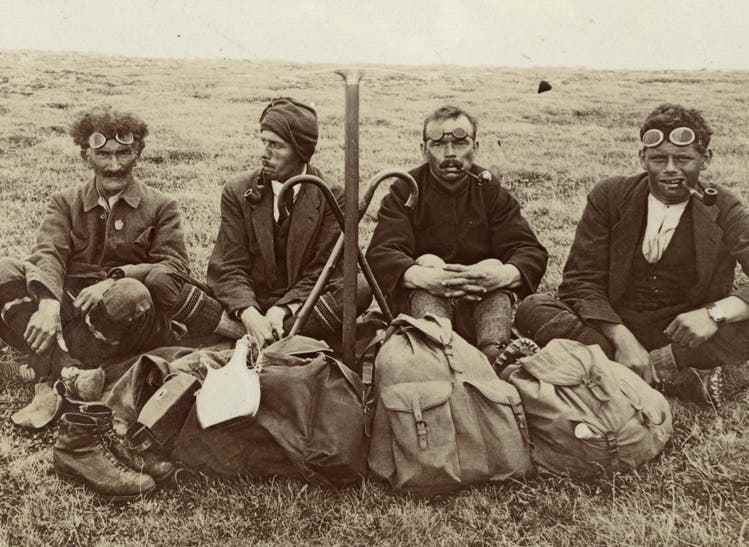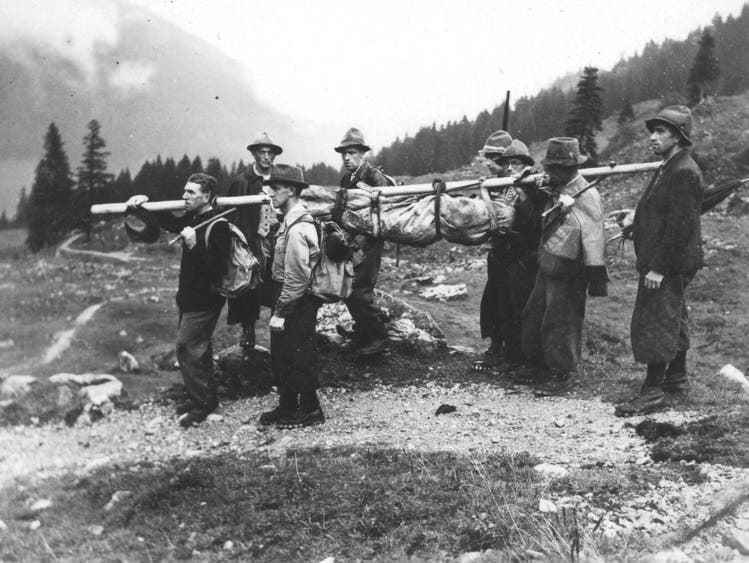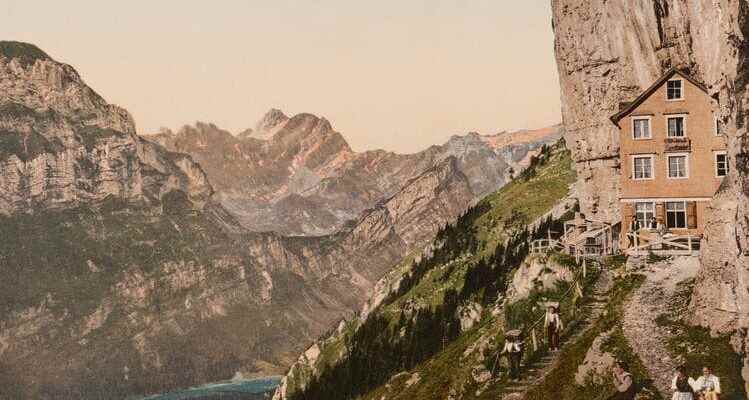From the middle of the 19th century, the number of tourists in the Alpstein increased steadily – and with it the alarmingly high number of fatal mountain accidents.
Aescher and Wildkirchli were already popular destinations in the 19th century.
The Alpstein is “perhaps the most beautiful mountain range on earth,” said someone who could judge it better than almost anyone else: Albert Heim (1849-1937), one of the most influential natural scientists of his time, Zurich geology professor, sought-after expert and excellent panorama artist. In 1870/71 he worked for a total of 34 days on the summit of the Säntis on the panorama that was to become one of his greatest masterpieces. For him, the work on and with the mountain, “immersing oneself in the magnificent mountain forms”, was “work and pleasure” at the same time.
Floating on pink clouds
Heim was an enthusiastic and experienced mountaineer, and yet it caught him too: in the spring of 1871, while descending from the summit, he lost his balance, slipped down a snow field lying face down on his back and finally shot about twenty meters over a ledge. He only survived because he landed on a snow ridge. Heim was unconscious for about half an hour.
Twenty years later he published “Notes on death from a fall” in the yearbook of the Swiss Alpine Club (SAC), in which he processed his own accident and the experiences of other mountaineers. He described what decades later would be called a “near-death experience”: how he watched his whole life roll by like in a movie and how he floated “in heavenly light” on pink and purple clouds: “Everything was beautiful and without pain, without Fear without pain.” Heim also wanted his descriptions to be understood as consolation for the bereaved of mountaineers who had fallen.

Even for experienced climbers like these daring men from around 1900, the Alpstein offers some challenges.
Eduard Imhof, the famous cartographer, also grossly underestimated the mountain when he climbed it in 1927 to rework Albert Heim’s panorama. For an “enterprising mountaineer heart”, the Säntis is to a certain extent a “lady’s mountain”, Imhof thought. Later, however, he got so carried away that he only arrived at his destination, the Tierwis hut, at four in the morning. Imhof admitted that the “damenberg” suddenly became a “bad-tempered Himalayan giant”.
The tourists, who populated the Alpstein in increasing numbers from the middle of the 19th century, were even more at risk than the experienced naturalists. Johann Gottfried Ebel had expressly warned against climbing the Säntis in Switzerland’s first useful travel guide, the “Instructions for Traveling Switzerland in the Most Useful and Enjoyable Way” published in 1793. These are “connected with real danger for anyone who is not particularly used to rock climbing and does not have a sure foot and a head free from giddiness”.
From around 1870, the SAC sections in the Alpstein expanded the various paths and turned former climbing routes such as the ascent from the Schwägalp or the Lisengrat into reasonably easy hiking trails. They entrusted the task to local locksmiths, who made the rock accessible with countless iron steps and wire ropes. However, this also meant that the number of mountain tourists increased again – and those responsible for the SAC must have felt like sorcerers’ apprentices who were no longer able to cope with the matter.
The train increases the problem
In 1871, the national SAC dealt with the increasing number of accidents for the first time – and from then on reported on it annually. From the descriptions one learns, for example, that there were four fatal mountain accidents in the Alpstein region in 1889. In 1890, two mountaineers went astray and could not be rescued before the onset of winter. The SAC sections around the Säntis decided a little later to organize the rescue service in the Alpstein area together.
The construction of the suspension railway from Schwägalp to Säntis in 1935 brought significantly more day trippers to the “Appenzeller high mountains” – which also meant that the number of people killed in accidents rose again rapidly. The annual report of the SAC St. Gallen for 1944 states that four rescue operations and four corpse recovery operations had to be carried out in that year alone. “The fatal accidents that follow quickly are not only a concern for us, but also for the Central Committee of the SAC,” it continues. There have been 28 deaths in the past few years in the area of the SAC section in St. Gallen alone. Nine of the accident victims slipped, six times the “edelweiss addiction” led to the crash.

The victim of a mountain accident is being transported away. In 2010, the Appenzell Museum dedicated an exhibition to the tragic side of mountain hiking in the Säntis region.
In the mid-1960s, a sudden increase in rescue operations and fatal accidents had to be registered again. The rescue chief of the SAC section St. Gallen reported 13 missions in 1965, 31 in 1966 and even 40 in 1967. The main problem was the poorly equipped tourists, he wrote.
103 mountain deaths in 23 years
In 1964, a doctor published accident statistics in the “Appenzellische Geschichtsblatt” according to which 103 people died in the Alpstein within 23 years – not even counting people who suffered a stroke on the way. In addition to slipping in the snow, the following was mentioned more often than average: “a fall while looking for edelweiss”.
In the years to come, the maintenance of the paths was improved, which somewhat mitigated the problem. In his 1965 report, however, the St. Gallen rescue chief found that the number of accidents could hardly ever be significantly reduced: “The number of mountain accidents in the Alpstein is very high compared to other similar mountain areas in our country. That’s not really surprising when you know the large number of visitors that pour into the Alpstein on every nice day.»
